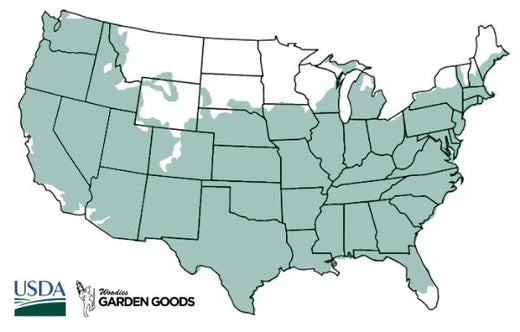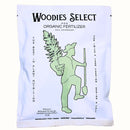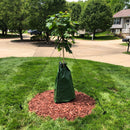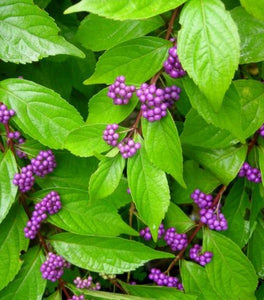
Images Depict Mature Plants
Forest Pansy Redbud Trees for Sale Online
The Forest Pansy Redbud (Cercis canadensis ‘Forest Pansy’) is a breathtaking ornamental tree prized for its vibrant, heart-shaped foliage and striking seasonal color. In early spring, before the leaves emerge, this Eastern Redbud cultivar dazzles with an explosion of vivid rose-purple blooms that cover its bare branches, providing an early nectar source for pollinators. As the flowers fade, the real show begins—deep burgundy to purple foliage unfurls, creating a bold contrast in any garden or landscape. The leaves retain their rich hue through early summer before transitioning to shades of green, gold, and orange in fall, offering multi-season visual interest.
Ideal for smaller yards or as a specimen tree in a mixed border, the Forest Pansy Redbud typically reaches 20 to 25 feet tall and wide. It thrives in full sun to partial shade and prefers moist, well-drained soil. This cultivar of the native Eastern Redbud is both deer resistant and low maintenance, making it an excellent choice for gardeners looking to add bold color and native beauty to the landscape. It’s especially stunning when placed against evergreen backdrops or paired with contrasting perennials and shrubs.
Hardy in USDA Zones 5–9, the Forest Pansy Redbud combines ornamental value with ecological benefits. It attracts bees and other early-season pollinators while supporting local wildlife. Whether used as a front yard focal point, an understory tree in a woodland garden, or a standout accent near patios and walkways, this tree delivers year-round charm. Its elegant form, rich foliage, and early blooms make the Forest Pansy Redbud a top pick for four-season garden appeal.

| Hardiness Zone: | 5-9 |
|---|---|
| Mature Height: | 20 to 25 feet |
| Mature Width: | 20 to 25 feet |
| Classification: | Broad Leaved deciduous flowering tree |
| Sunlight: | Full Sun to Partial Sun |
| Habit: | Upright, spreading |
| Foliage: | Rich maroon-red |
| Flower Color: | Bright Rosy-Pink |
| Pruning Season: | Late spring after flowering |
| Soil Condition: | Any well drained soil |
| Water Requirements: | Water well until established |
| Uses: | Tolerates moist soil and full sun. Full sun brings out the best fall color. Will adapt to drier sites |
How to Care for Forest Pansy Redbud
Be sure to read our planting instructions to ensure a healthy and happy Forest Pansy Redbud tree for years to come!
How Should I Plant my Forest Pansy Redbud Tree?
Planting your Forest Pansy Redbud Tree (Cercis canadensis ‘Forest Pansy’) begins with selecting the right location—choose a spot that receives full sun to partial shade for optimal flowering and foliage color. This tree thrives in moist, well-drained soil that is rich in organic matter, although it can tolerate a range of soil types. To plant, dig a hole twice as wide and just as deep as the tree’s root ball. Gently remove the tree from its container, loosen the roots, and place it in the hole with the top of the root ball level with the surrounding soil. Backfill with a mix of native soil and compost, water thoroughly to settle the soil, and apply a 2–3 inch layer of mulch around the base to retain moisture and suppress weeds. Be sure to keep mulch a few inches away from the trunk to prevent rot, and water the tree regularly during the first growing season to establish a strong root system. Space your Forest Pansy Redbud at least 15–20 feet from buildings, driveways, or other trees to allow for its mature size of 20–25 feet tall and wide. This ornamental tree makes a stunning focal point in front yards, mixed borders, or woodland gardens, offering year-round interest with its early spring blooms, rich purple foliage, and attractive branching structure. Proper planting ensures your Forest Pansy Redbud will thrive and deliver vibrant seasonal color and native beauty for years to come.
How Should I Water my Forest Pansy Redbud Tree?
Watering your Forest Pansy Redbud Tree (Cercis canadensis ‘Forest Pansy’) correctly is key to ensuring healthy growth and vibrant foliage. During the first year after planting, water deeply once or twice a week, depending on rainfall and soil type, to keep the soil consistently moist but not soggy. A slow, deep soak encourages deep root development and helps the tree establish more quickly. Apply water at the base of the tree and avoid wetting the leaves to prevent disease. Using mulch around the root zone will help retain moisture and regulate soil temperature, especially in warmer climates. Once established, Forest Pansy Redbud trees are moderately drought-tolerant but still benefit from occasional deep watering during extended dry periods, particularly in summer. Check the soil by feeling the top few inches—if it’s dry, it’s time to water. Be mindful not to overwater, as redbuds dislike overly saturated soil. Maintaining a consistent watering routine in the first few years will ensure strong root development, vibrant spring blooms, and rich burgundy foliage throughout the growing season. With proper watering, your Forest Pansy Redbud will thrive as a colorful, low-maintenance focal point in your landscape.
How Should I Fertilize my Forest Pansy Redbud Tree?
Fertilizing your Forest Pansy Redbud Tree (Cercis canadensis ‘Forest Pansy’) should be done carefully to encourage healthy growth and vibrant foliage without overstimulating the tree. In early spring, just before new growth appears, apply a balanced, slow-release fertilizer such as a 10-10-10 or 12-12-12 formulation. Spread the fertilizer evenly around the tree’s root zone, starting several inches away from the trunk and extending out to the drip line. Water thoroughly after applying to help nutrients absorb into the soil and reach the root system. Avoid excessive fertilization, especially with high-nitrogen products, as this can lead to overly lush growth and reduced flowering. For a more organic approach, top-dress with compost or well-aged manure in early spring to enrich the soil gradually and improve structure. Forest Pansy Redbuds typically thrive with a single annual feeding in fertile soils, making them a low-maintenance yet showy addition to the landscape. Proper fertilization supports strong blooming in spring and deepens the signature burgundy-purple foliage that makes this ornamental tree a standout in mixed borders, front yard plantings, or woodland gardens.

How and When should I Prune my Forest Pansy Redbud Tree?
Pruning your Forest Pansy Redbud Tree (Cercis canadensis ‘Forest Pansy’) should be done in late winter to early spring, while the tree is still dormant and before new growth emerges. This is the ideal time to remove dead, damaged, or diseased branches, as well as any crossing limbs that may interfere with the tree’s naturally graceful, vase-like shape. Start by thinning out crowded areas to improve air circulation and sunlight penetration, which helps reduce the risk of disease and promotes healthy blooming. Use clean, sharp tools to make cuts just outside the branch collar for proper healing. You can also perform light summer pruning if necessary to remove water sprouts or suckers that may form along the trunk or lower branches. Avoid heavy pruning in late summer or fall, as this can stimulate new growth that may not harden off before winter. Forest Pansy Redbuds bloom on old wood, so any major structural shaping should be done right after the flowers fade to preserve next year’s bloom potential. With thoughtful and timely pruning, your Forest Pansy Redbud will maintain its strong structure, showcase its rich burgundy foliage, and produce a stunning floral display each spring.


















